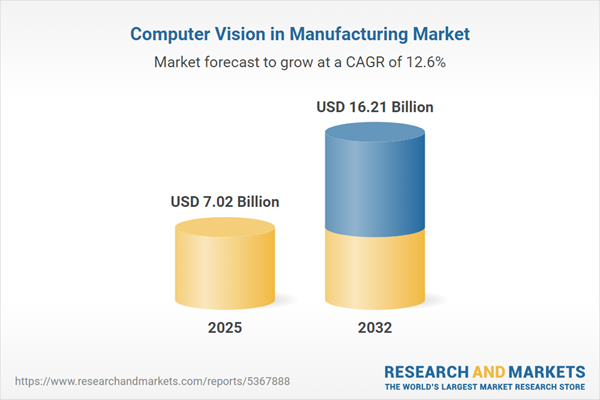Speak directly to the analyst to clarify any post sales queries you may have.
The computer vision in manufacturing market is evolving from experimental implementations to essential production systems, enabling manufacturers to drive operational efficiencies, quality assurance, and real-time automation at scale. As digital transformation accelerates, decision-makers face new priorities and practical challenges when selecting and deploying advanced vision technologies across global factory environments.
Market Snapshot: Computer Vision in Manufacturing Market Growth
The computer vision in manufacturing market grew from USD 6.27 billion in 2024 to USD 7.02 billion in 2025. It is expected to continue expanding at a CAGR of 12.59%, reaching USD 16.21 billion by 2032. Strategic adoption is accelerating as core visual inspection, predictive analytics, and real-time guidance applications become critical for manufacturers seeking to enhance productivity, safety, and compliance within diverse industry segments.
Scope & Segmentation
- Offerings: Cameras, lightings, optics, processing modules, consulting and design services, system integration, training and certification, AI & deep learning algorithms (anomaly detection, classification, object detection), application platforms (dashboarding, reporting, no-code/low-code tools, workflow and recipe management), machine vision libraries, annotation and labeling, training and AutoML.
- Dimensionality: 2D machine vision, 3D machine vision.
- Data Types: 3D point cloud, image, video.
- Applications: Code reading and traceability, inventory management, predictive maintenance, process monitoring and optimization (palletizing, depalletizing, pick-and-place, tool alignment and calibration), quality inspection and defect detection (assembly verification, surface defect detection), robotics guidance, safety and compliance monitoring.
- Industry Verticals: Aerospace and defense, automotive, electronics and semiconductor, food and beverage, metals and machinery, pharmaceutical and healthcare.
- Enterprise Size: Large enterprises, small and medium enterprises.
- Deployment Mode: Cloud, on-premise.
- Regions Covered: Americas (North America, Latin America), Europe, Middle East & Africa, Asia-Pacific, with sub-regional analysis for major manufacturing economies.
- Company Coverage: ABB Ltd., Fujitsu Limited, Cognex Corporation, Artemis Vision, Basler AG, Baumer Holding AG, Clarifai Inc., Fastec Imaging Corporation, GE Vernova, Google LLC by Alphabet Inc., Heliovision, IFM Electronic GmbH, Intel Corporation, International Business Machines Corporation, ISRA VISION GmbH, Keyence Corporation, Microsoft Corporation, ML2Grow, Nexus Integra, NVIDIA Corporation, OMRON Corporation, Oracle Corporation, Sick AG, Siemens AG, Softengi, Teledyne Technologies Incorporated, Xometry Europe GmbH, Zebra Technologies Corporation, Acquired Data Solutions, TKH Group N.V., OPT Machine Vision Tech Co., Ltd., Deutsche Post AG, Cincoze Co., Ltd., viso.ai AG, Azilen Technologies Pvt Ltd, Sony Corporation.
Key Takeaways for Senior Decision-Makers
- Industrial computer vision is no longer limited to pilots; it is foundational to operations, enabling defect detection, continuous improvement, and real-time process management.
- Adoption is shaped by hardware and software synchronization, with growing use of both 2D and 3D sensing for distinct inspection and measurement tasks.
- Regional dynamics, including local compliance and supply chain strategies, significantly impact solution selection, deployment, and total cost of ownership.
- Segmented approaches based on enterprise size and industry are critical—large manufacturers standardize data and systems for governance while SMEs prioritize modular, turnkey vision solutions for rapid ROI.
- Strategic vendor and partner selection, modular architecture, and supportive data governance reduce deployment friction and ensure scalable, measurable operational gains.
- Competitive landscape favors providers demonstrating proven production outcomes, robust support, and future-proof integration pathways.
Tariff Impact on Procurement and Supply Chains
Recent tariff measures have reshaped the procurement and supply chain landscape for computer vision deployments. Tariffs on imaging components, optics, and controllers have increased import costs, encouraging diversification of supplier bases and greater inventory resilience. These shifts are accelerating trends towards regional assembly, localization, and long-term supplier partnerships. Buyers are seeking flexible architectures to adapt to component-level price variability, placing greater emphasis on software extensibility and modular upgrades.
Methodology & Data Sources
This research employs a mixed-methods approach, integrating structured interviews with engineering, operations, and procurement leads, technical consultations with system integrators, and analysis of peer-reviewed literature and vendor resources. Analytical methods include capability mapping, risk-impact assessment, and triangulation to validate insights across primary and secondary sources.
Why This Report Matters
- Equips executive teams with an actionable framework to prioritize, scale, and govern vision-enabled manufacturing solutions amid evolving trade and technology landscapes.
- Provides differentiated segmentation, regional adoption insights, and vendor strategies to inform investments and operational planning.
Conclusion
This report guides industry leaders as computer vision transitions from pilot deployments to a core enabler of industrial excellence. Disciplined adoption, architecture standardization, and strong governance deliver sustainable advantages in efficiency, quality, and resilience.
Additional Product Information:
- Purchase of this report includes 1 year online access with quarterly updates.
- This report can be updated on request. Please contact our Customer Experience team using the Ask a Question widget on our website.
Table of Contents
3. Executive Summary
4. Market Overview
7. Cumulative Impact of Artificial Intelligence 2025
Companies Mentioned
The companies profiled in this Computer Vision in Manufacturing market report include:- ABB Ltd.
- Fujitsu Limited
- Cognex Corporation
- Artemis Vision
- Basler AG
- Baumer Holding AG
- Clarifai, Inc.
- Fastec Imaging Corporation
- GE Vernova
- Google LLC by Alphabet, Inc.
- Heliovision
- IFM Electronic GmbH
- Intel Corporation
- International Business Machines Corporation
- ISRA VISION GmbH
- Keyence Corporation
- Microsoft Corporation
- ML2Grow
- Nexus Integra
- NVIDIA Corporation
- OMRON Corporation
- Oracle Corporation
- Sick AG
- Siemens AG
- Softengi
- Teledyne Technologies Incorporated
- Xometry Europe GmbH
- Zebra Technologies Corporation
- Acquired Data Solutions
- TKH Group N.V.
- OPT Machine Vision Tech Co., Ltd.
- Deutsche Post AG
- Cincoze Co., Ltd.
- viso.ai AG
- Azilen Technologies Pvt Ltd
- Sony Corporation
Table Information
| Report Attribute | Details |
|---|---|
| No. of Pages | 185 |
| Published | November 2025 |
| Forecast Period | 2025 - 2032 |
| Estimated Market Value ( USD | $ 7.02 Billion |
| Forecasted Market Value ( USD | $ 16.21 Billion |
| Compound Annual Growth Rate | 12.5% |
| Regions Covered | Global |
| No. of Companies Mentioned | 37 |









